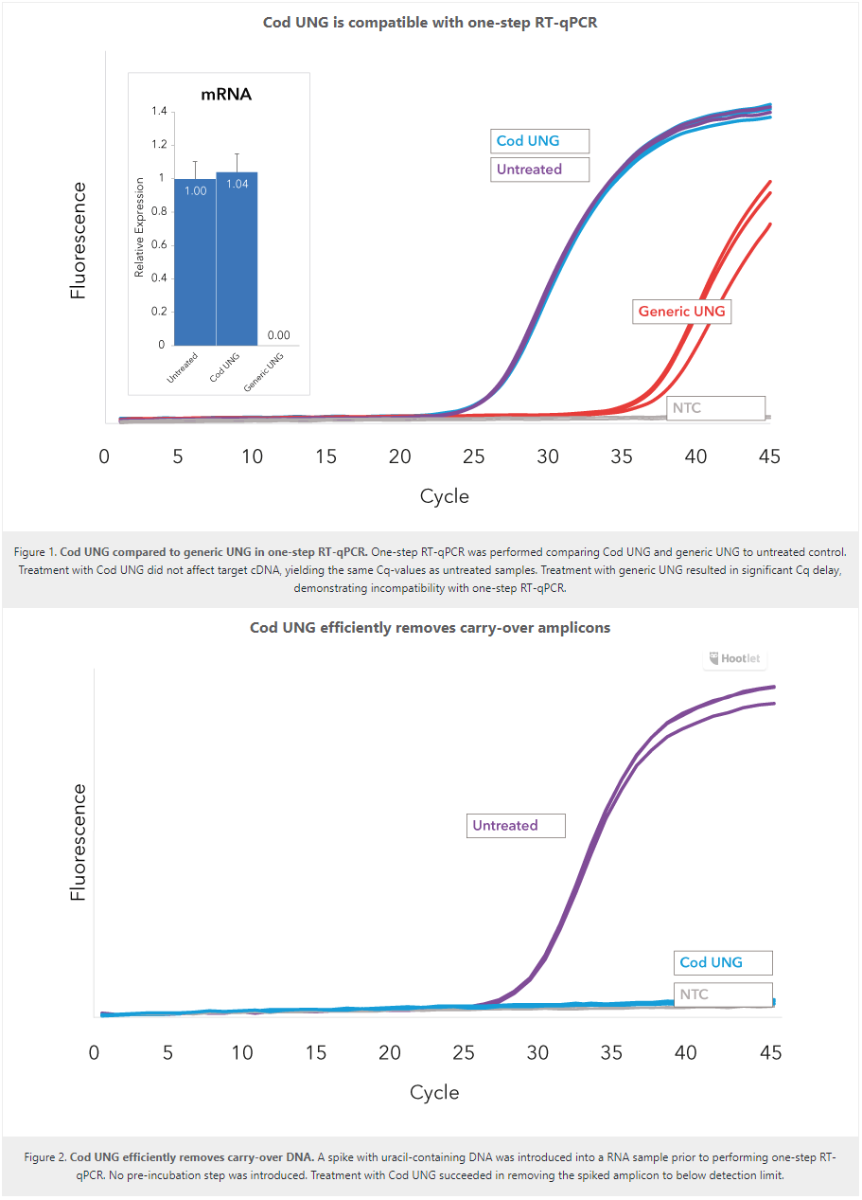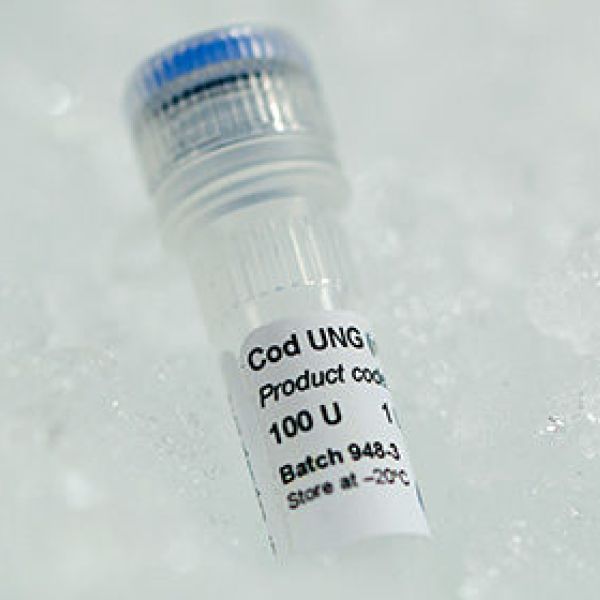Cod Uracil-DNA Glycosylase
Cod Uracil-DNA Glycosylase
Cod Uracil-DNA Glycosylase (Cod UNG) from Atlantic Cod is the only commercially available UNG enzyme that is completely and irreversibly inactivated by moderate heat treatment. The enzyme is produced in a recombinant E. coli (ung-) strain that contains a modified Cod UNG gene.
Main advantages with Cod UNG
- Heat-labile
- Completely and irreversibly inactivated at 55°C
- Use of Cod UNG makes contamination control possible in RT-PCR
- Does not degrade PCR product post-PCR. This makes downstream use of the PCR product possible
- High purity enzyme, tested free of contaminating nucleases
Properties
Specifications
- Unit definition: One Unit will liberate 1 nmol Uracil from Uracil-containing DNA per hour at 37°C.
- Specific activity: >500 000 Units/mg.
- Purity: Purified to apparent homogeneity by SDS-PAGE. No nuclease activity is detected.
- Concentration: Minimum 1 000 Units/ml.
Stability
Minimum shelf life at -20°C is 2 years. In practice we find that storage at 4°C is possible for at least 6 months. The enzyme activity is also preserved upon multiple freeze-thaw cycles.
Cod UNG is the only UNG compatible with one-step RT-qPCR
In reverse transcriptase qPCR (RT-qPCR), RNA is the initial template. However, the problem of carry-over contaminants can be as much of a problem here as in regular PCRs. Following reverse transcription, cDNA is the template for the PCR. If your sample is contaminated with carry-over PCR products from previous PCRs, the primers cannot distinguish between cDNA and carry-over DNA, resulting in erroneous results.
In one-step RT-qPCR kits, RNA is added to a master mix containing both reverse transcriptase and polymerase, allowing cDNA synthesis and qPCR in the same tube. E. coli UNG/UDG has an optimal working temperature up to approx. 50˚C and generally retains its activity up to approx. 70˚C. This temperature range is not compatible with carry-over prevention in one-step RT-qPCR protocols, as E.coli UNG/UDG would remove uracil incorporated into the cDNA during reverse transcription, thereby causing degradation of template.
Recombinantly expressed Cod UNG from ArcticZymes was originally isolated from the cold-adapted organism Atlantic cod. Cod UNG is highly active at temperatures ranging from 20˚C to 40˚C, quickly lose activity at temperatures above 42˚C and is irreversibly inactivated already at 55˚C. Since the optimum temperature range of Cod UNG is considerably lower compared to that of E. coli UNG/UDG, Cod UNG is compatible with use in single tube RT-qPCRs. Carry-over prevention is simply carried out by adding Cod UNG to a final concentration of 0.01 U/µl and introduce a 5 minute incubation step at 25˚C prior to initiation of RT-qPCR. Alternatively, the concentration can be increased to 0.04 U/µl and the pre-incubation step omitted. Cod UNG will efficiently remove carry-over contamination during sample setup and cycler ramping.
Here we show that Cod UNG can be used for carry-over prevention in a commercial one-step RT-qPCR master mix containing dUTPs instead of dTTPs. Treatment with Cod UNG did not affect target cDNA, yielding the same Cq-values as untreated samples. For comparison, treatment with a generic UNG resulted in significant Cq delay, demonstrating incompatibility with one-step RT-qPCR.

- Hypermethylated DNA, a circulating biomarker for colorectal cancer detection
Rasmussen SL, Krarup HB, Sunesen KG, Johansen MB, Stender MT, et al.
PLOS ONE 12(7), 2017. doi.org/10.1371/journal.pone.0180809 - Biofilm formation and antibiotic resistance in Klebsiella pneumoniae urinary strains
Vuotto, C., Longo, F., Pascolini, C., Donelli, G., Balice, M.P., Libori, M.F., Tiracchia, V., Salvia, A. and Varaldo, P.E.
J Appl Microbiol (2017), 123: 1003–1018. doi:10.1111/jam.13533 - Cell-free DNA promoter hypermethylation in plasma as a diagnostic marker for pancreatic adenocarcinoma
Henriksen SD, Madsen PH, Larsen AC, et al. (2016)
Clinical Epigenetics, 8, 117. http://doi.org/10.1186/s13148-016-0286-2 - Inter- and intraspecific variation in the surface pattern of the dermal bones of two sturgeon species
Thieren, E., Ottoni, C., Popović, D. and Van Neer, W. (2016)
Journal of Applied Ichthyology. doi: 10.1111/jai.13091


